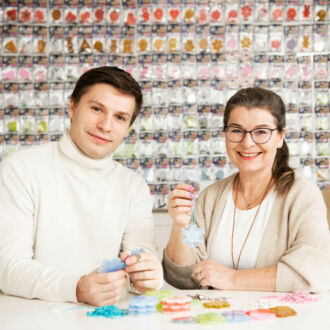Finnish culinary culture is infused with the natural flavours of the northern latitudes. It tells the story of a people who went from forest livelihoods to active interaction with neighbouring countries.
The tale progresses to the newest international trends and the height of excellence. Finnish professionals have placed Finland on the gastronomic world map and made the capital, Helsinki, one of the globe’s most intriguing, trend-setting cities.
Genuine flavour
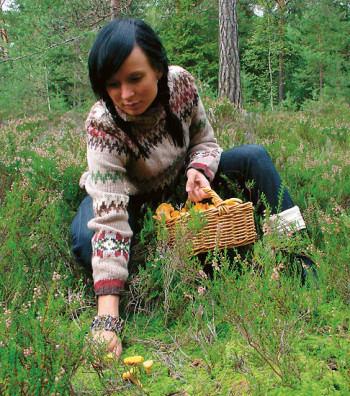
The golden chanterelle is the favourite mushroom of many Finns. Appearing earlier than many other mushrooms, the first chanterelles are picked at midsummer to accompany new potatoes, with the season continuing all the way into the game and mushroom dishes of autumn.Photo: Promotion Programme for Finnish Food Culture (SRE)/Imagebank
The brilliant array of flavours stems from our four distinct seasons. Gently braised root vegetables and meat casseroles are a wonderful way to counteract the chill of winter. The spring sun – and steaming soups – melt even the most stubborn frost, with rhubarb and nettles the first delicacies to appear in the new growing season. Delicious “new potatoes,” harvested when small and tasty, are a staple of the dining table throughout early summer. Berries and mushrooms ripen for picking as summer progresses, while autumn is the time to store nature’s bounty for winter. Wild game and fresh fish provide seasonal variation throughout the year. It’s always a good season for Finnish food!
In Finland, nature produces food that is bursting with healthiness and genuine flavour. Bilberries from the wooded wilderness, cranberries from wild wetlands, rye from fields that have known winter frost − Finland is packed with superfoods!
Culinary Finland calling
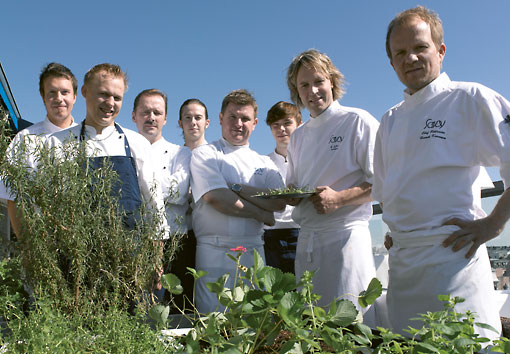
Innovation is also abundant outside the kitchen. Restaurant Savoy has begun rooftop gardening in the centre of Helsinki. The kitchen staff and customers love the fresh herbs and vegetables grown on the roof that is also home to a community of honeybees.Photo: Royal Restaurants
Finnish international-level chefs are taking their cuisine to the world and inviting the world’s foodies to our tables.
Our innovators blend arctic ingredients; traditional preservation methods and cooking techniques; heritage dishes; and inspiration gained around the world to create experiences that will impress the most seasoned of gourmands.
In this approach to food, originality stems from small producers who boast premium-quality products with a unique touch: reindeer, a huge selection of wild mushrooms, indigenous Finnish cattle, intensely flavourful root vegetables, lush greens and tangy berries, to name a few. Artisan bakeries, cheese makers and breweries help restaurants create fantastic cuisine in which the authentic flavours of the ingredients shine through.
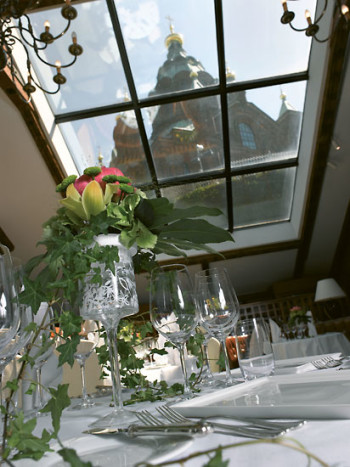
There are opportunities for fantastic fine dining at numerous classy restaurants. The capital, Helsinki, is dotted with them, but there are unforgettable food experiences galore elsewhere in Finland as well.Photo: Royal Restaurants
Finnish restaurants cultivate great respect for tradition. Would you like some Baltic herring breaded in rye flour and fried in butter to a glorious crispness? Or how about elk or venison with roasted root vegetables? Perhaps a slice of bilberry tart with vanilla sauce?
Restaurants are also constantly reinterpreting old favourites and developing new dishes. Fantastic whitefish (Finnish lavaret) may be seasoned with organic herbs grown on the restaurant’s roof terrace, while beetroot is no longer just pickled but presented in a myriad of exciting ways. Those who want something out of the ordinary should also look out for some of the sensational liquorice desserts our restaurants have on offer.
Winds of change
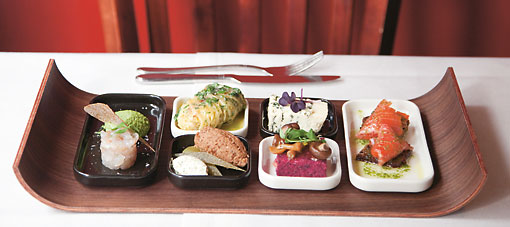
Traditional Finnish flavours are given modern takes and making new friends at restaurants.Photo: SRE/Imagebank
Culinary culture is changing in Finland as it is all over the world, with food trends such as the organic and local food movements; food that enhances wellbeing; and exploration of new ingredients and ideas.
The entire food chain is moving towards more sustainable choices. Organic farming is widespread in Finland and the market is developing steadily. A rediscovered passion for local food has caught on rapidly. Finns are the third-biggest per capita consumers of Fairtrade products in the world. Carbon and water footprint labelling is being introduced in food packaging.
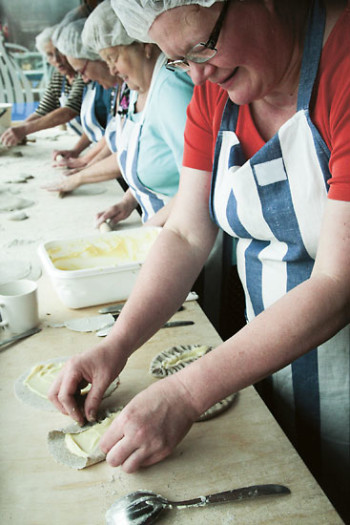
The art of making Karelian pasties is one of the old culinary skills that is still very much alive in Finland. Rice, or more traditionally barley, is baked inside a very thin rye crust. It takes some practice to perfect the finger skills required for the folding technique.Photo: SRE/Imagebank
The flow of geographical changes also influences our food culture. The roots of traditional Finnish cuisine lie in Karelia in the east and on the shores of the Gulf of Bothnia in the west. Regional differences have become smaller but are still readily apparent. From our eastern heritage come oven-baked casseroles and the traditional delicacies laid out to celebrate Easter. Western traditions include soups and many of the dishes enjoyed during the biggest culinary feast of the year, Christmas. Reindeer from the northern Finnish region of Lapland forms a treat that is also appreciated in the southern areas of the country, and Karelian pasties have become a nationwide favourite as well as a link with history (part of Karelia was ceded to the Russians after the Winter War of 1939 and 1940).
One of the easiest ways to differentiate the regions is the local style of bread: unleavened flatbreads in the north, sweet-flavoured loaves in the west, sourdough rye bread and pasties in the east, and islander’s bread in the coastal areas of the south. The latter is a black, sweet loaf that keeps for ages.
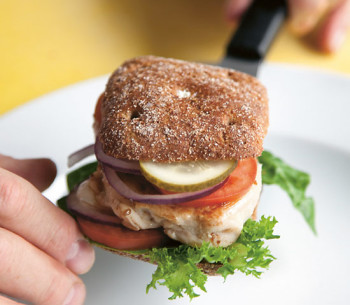
The epitome of Finnish food culture − rye bread − is acquiring new forms.Photo: SRE/Imagebank
Changes in our lifestyle also affect our food culture. Everyday life is a lot less physically strenuous than it used to be, so instead of creamy milk many opt for lighter alternatives and watch their sugar intake. As microwave ovens, pre-prepared food and eating out in restaurants became commonplace, time previously devoted to cooking was freed up for other activities. At the same time, cooking has become a popular hobby and is inspiring a young generation of foodies to spend time in the kitchen.
International influences can be seen in the wide selection of ethnic restaurants, but Finnish creativity has also transformed many foreign styles into something new. Eclectic treats well worth tasting include barley risotto, reindeer carpaccio, Finnish shiitake mushrooms or sapas (Finnish tapas – the “s” comes from Suomi, the Finnish word for “Finland”).
Symphony of wild nature
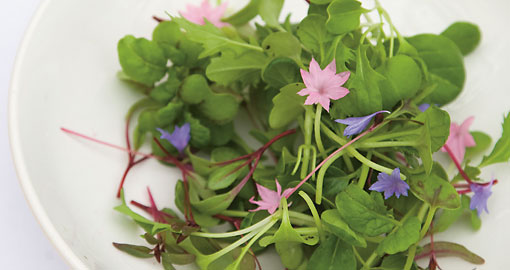
Finland’s natural environment is very lush and rich during the summer. Collecting wild herbs is a component of ancient food knowledge that has become part of the food trends of recent years. Today many restaurants even use wild herbs that their chefs have picked themselves.Photo: SRE/Imagebank
For many Finns and foreigners, the most exciting Finnish food adventures have their origins in the wild. Unforgettable experiences can be conjured up from berries, mushrooms, freshwater fish and game.
Everyone can access nature’s local superfoods in Finland. The traditional Finnish legal concept of “every person’s right” allows anyone to go hiking and to collect berries and mushrooms almost anywhere, as long as they respect the environment and landowners. Bilberries, lingonberries, chanterelles and boletus mushrooms are greatly savoured all year long. Many Finns pick wild berries and freeze them instead of buying them at grocery stores – a habit that is a source of wonder for many foreigners.

Wild arctic bilberries and lingonberries are bursting with flavour and health-promoting nutrients. An outing to pick berries is also soothing for the soul.Photo: Rodeo/P. Jauhiainen
Our thousands of lakes offer tasty freshwater fish, and the Baltic Sea offers a source of ocean fish varieties. A fishing licence is easy to obtain, which means many people can enjoy fresh fish. At holiday homes and summer cottages – another special feature of Finland accessible to most of the population – people prepare fish on the barbecue or in a smoker. Special seasons exist for various seafood delicacies: Early autumn means boisterous crayfish parties, and the winter is the time to enjoy burbot, as well as roe with blinis, Russian-style buckwheat pancakes. Ice-fishing – dropping a line through a hole in a frozen lake or ocean – forms a unique experience to try if you visit Finland in the winter.
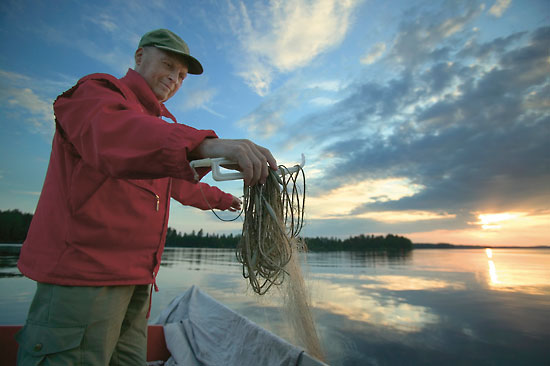
Finland has thousands of lakes that offer a plentiful catch of fish. At the summer cabin, fishing equipment is conveniently available, and preparing and eating the fish is a breeze after a successful fishing trip.Photo: Plugi
Many households enjoy meat from game hunted by family members. Mostly this means elk, but it can also be wild reindeer, hare, mallard or wood pigeon. In Finnish Lapland, reindeer herders own groups of animals that roam the fells.

In Lapland hikers do not need to carry water. There are clear mountain springs for a refreshing drink wherever you go.Photo: Visit Finland/Marja Pirilä
Clean water forms a source of great pride for the Finns. Accessible groundwater can be found in almost every part of Finland. It’s utilised by homeowners and waterworks, and can usually be consumed without any treatment. Other sources of drinking water include lakes, of which Finland possesses more than 188,000. The liquid passes through purification treatment before use in homes and restaurants.
Finnish bilberries have many fans in Japan, boletus mushrooms are popular in Italy and birch sap is exported to France. Great demand exists for wild-harvested produce around the world.
The world’s northernmost agriculture

Agriculture is in capable hands in northern latitudes. The short growing season keeps farmers busy during planting and harvest alike.Photo: SRE/Imagebank
No other country in the world possesses farmland that stretches this far north. Finland’s short summer and long winter pose challenges for those growing crops or raising livestock. In earlier days that meant a shortage of food in the winter. Nowadays it means creative solutions and quality food.
The growing season is short. The entire cultivation process has to be completed two months faster than in the warmer south. Autumn harvests need to take place swiftly, within just a few weeks, before winter sets in.
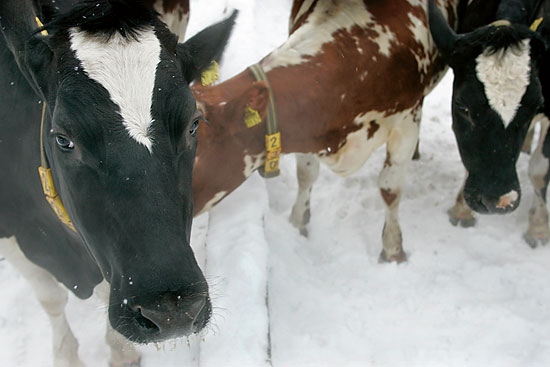
During winter, fields rest beneath a cover of snow, but many cows enjoy these white pastures, too.Photo: SRE/Imagebank
The light of the long summer days, the warmth of the Gulf Stream and unique local plant varieties make fast growth possible. The amount of solar radiation received overall in Finland during the growing season is even greater than in continental Europe. Growth is also helped by the fact that in summer it is rarely too hot or dry, and there is always enough water available for irrigation. Winter frosts effectively destroy some of the pests and slow down the growth of many weeds.
Another aspect that makes the growing season special is the great temperature difference between day and night. Herbs become greatly aromatic, and berries are packed with nutrients.
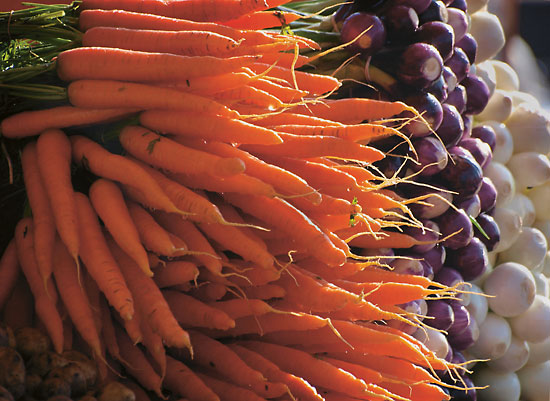
There is a bountiful supply of Finnish vegetables available in the autumn.Photo: Vastavalo/Tuula Roos
Finns are innovative developers of greenhouse practices. To create energy-efficient ways of growing vegetables, a lot of research has been put into reducing energy consumption. The resulting innovative methods mean that now greenhouse-grown cucumbers consume one-third less energy than a few decades ago.
There is no need for artificial pesticides in greenhouse cultivation, either. In the future eco-efficiency will play an even greater role. Urban cultivation will bring greenhouse production close to city consumers and may produce energy for local residents, as well as utilising surplus heat from nearby homes.
Top expertise for safety and health
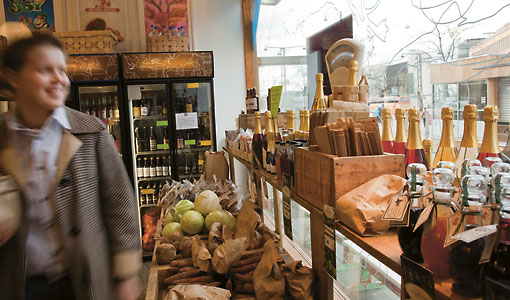
Organic and local produce have become staple choices among Finnish shoppers. Most is sold by ordinary supermarkets, but lots of new specialist shops have appeared. Often found in city centres, these shops offer urban foodies products made by artisanal producers in the countryside.Photo: SRE/Imagebank
Finnish food is the safest in the world. This excellence is based on high-quality agricultural ingredients. Strict hygiene procedures set the standard for the entire food chain.
Premises and equipment are meticulously cleaned, temperatures are kept at optimal levels and critical functions are subject to special monitoring. So you can enjoy eggnog made from fresh eggs, or allow your kids to scrape the mixing bowl to taste some cake batter.
Food allergies are taken seriously. Those suffering from lactose intolerance will find plenty of reliably labelled low-lactose and lactose-free dairy products in ordinary shops. There are gluten-free bakery products for those suffering from coeliac disease. In many restaurants, compatibility with special dietary requirements is indicated on the menu, and if not, the waiter will be able to provide the information.
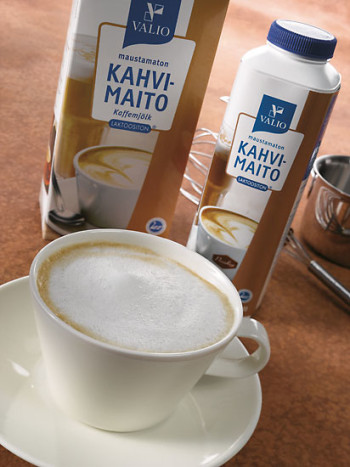
Lactose intolerance is fairly common in Finland. Since we are a nation of milk drinkers, there is a wide selection of lactose-free dairy products available.Photo: Valio
Functional foods represent the scientific zenith of health-promoting edibles. These scientifically researched products have special positive effects in addition to their conventional nutritional properties. The first Finnish functional food product to conquer the world was the tooth-friendly sweetener xylitol. It was followed by products that are good for the stomach, cholesterol levels and blood pressure.
Expertise in special diet products plays an important role in exports. Finnish lactose-free dairy products have gained a firm foothold in Sweden in recent years, and the conquest of America has begun. Italian sufferers of coeliac disease can enjoy pizza made in Finland. Finnish functional food products are sold in dozens of countries around the world.
New research is progressing all the time. One particularly interesting field of study seeks to combine bio-, nano- and information technologies. Technology applications are already being utilised for purposes such as weight management.
Above all, safe and healthy food is founded upon day-to-day cooperation between researchers, government authorities and the food industry, and upon the wise choices that consumers make.
Have a nice meal!
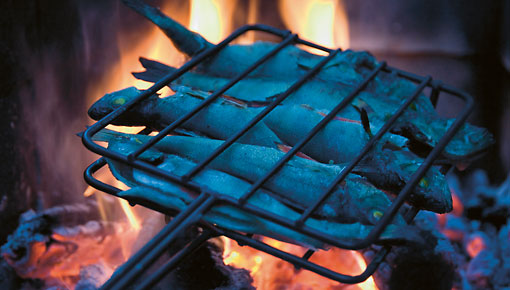
The heat of a campfire and the rustling of trees make a fish meal something very special.Photo: Rodeo/Juha Tuomi
The place to go for the best Finnish food is, of course, Finland. Whether enjoyed in the middle of the wilderness or at a classy restaurant, a Finnish meal always forms a wonderful experience for Finns and visitors alike.
On a nature trail or camping trip, sausages or newly caught perch taste perfect when grilled on an open fire and followed by a cup of freshly brewed coffee. If sitting on a tree stump in the middle of a dense forest feels slightly too exotic, there are plenty of well-equipped hiking areas with campfire sites set up for you. Or you can go for the easiest option and book a wilderness excursion with a guide.
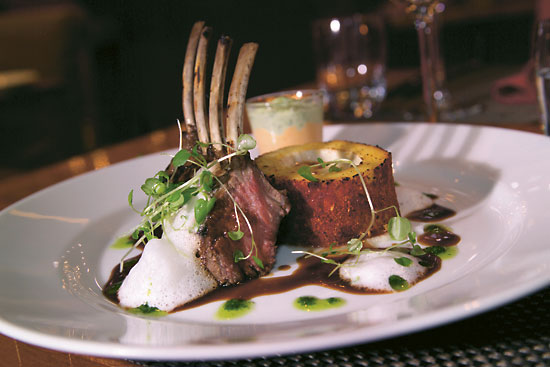
At gourmet restaurants you will find fabulous Finnish flavours served on your plate.Photo: Royal Restaurants
Lapland, the Finnish far north, presents an excellent location for taking in the beauty of nature. Local reindeer herders will take you to the fells to sample charred salmon, reindeer sauté and other delicacies. The best way to quench you thirst is with a gulp of sparkling clean water straight from a mountain stream or woodland spring. If you head for the islands or inland waters, you get to experience fish prepared in a multitude of ways, while numerous farm holiday providers offer traditional dishes in a rural setting. Visit a manor house restaurant to sample classic dishes and buffet tables that the gentry used to enjoy. You need look no further than many urban restaurants for a rustic meal or home-style food. Helsinki is the easiest place to find the very top of gourmet excellence, but plenty of fine dining experiences are also available elsewhere in Finland.
Finnish food can be found here and there around the world. Cheeses, alcoholic beverages, butter, pork and chocolate form our main culinary exports. Check your local supermarket shelves and you may be able to spot Finnish thin crisp rye bread, genuine dairy milk chocolate, organic muesli with Finnish organic oats or gluten-free frozen baguettes.
Are you inspired to have a go at making a Finnish meal? Check the internet for recipes in English and impress your family and friends.
Enjoy your meal!
Recipes
Top-notch pikeperch
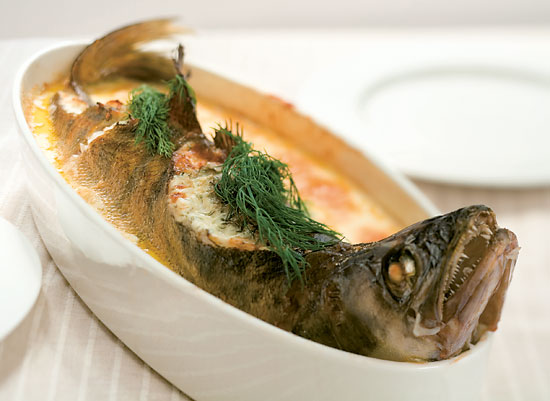
Photo: Simply Scandinavian/Kimmo Saira
- 1 pikeperch (zander), weighing around 1.5 kg, cleaned and scaled
- 300 ml double cream
- 1 spring onion
- dill
- 150 ml white wine
- 100 ml milk
- 100 ml fish stock
- 60 g butter
- salt
- white pepper
Chop the onion and fry lightly in butter. Set aside to cool. Chop the dill finely and mix the onion in a few drops of white wine.
Rinse the pikeperch in cold water. Make two slashes lengthwise into the back of the fish. Place the fish on its belly in an ovenproof dish. Season with salt and pepper. Put the mix of onion and dill into the slashes. Pour the rest of the white wine over the fish and cook in the oven at 160 ⁰C for 20 minutes.
Place a saucepan on low heat and put in the rest of the butter, the cream, fish stock and milk. Remove the fish from the oven and pour the creamy stock over it. Cook in the oven at 170 ⁰C for another 50 minutes. Baste the fish with the stock every 15 minutes. Decorate with fresh dill. Serve with new potatoes.
Recipe source: Simply Scandinavian*
Bilberry pie (Mustikkakukko)
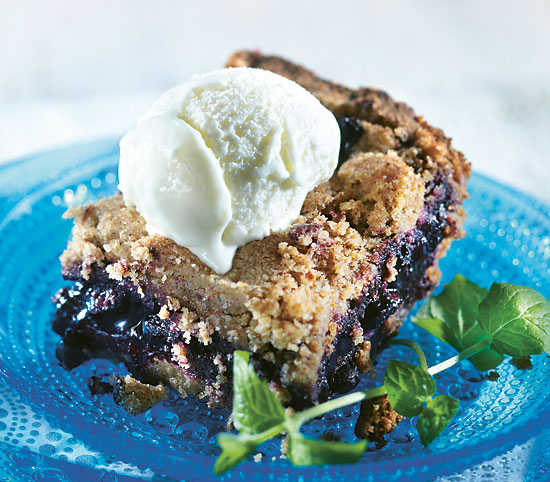
Photo: Pirkka Magazine
Mustikkakukko is a traditional dessert from eastern Finland. It combines the delicate taste of the bilberry and the robust energy of rye. Rye and bilberries are health-enhancing.
For the dough:
- 250 g butter, softened
- 150 ml sugar
- 400 ml rye flour (available from health food shops all over the world)
- 100 ml wheat flour
- 1 tsp baking powder
For the filling:
- 1 l bilberries or blueberries
- 100 ml sugar
Mix the butter and sugar. Mix the rye flour, wheat flour and baking powder and add to the sugar and butter mixture. Press about 2/3 of the dough onto the base and sides of a deep-sided oven dish.
Add fresh or frozen bilberries. (If you are using frozen bilberries, add 1 dessert spoon of potato starch.) Sprinkle sugar over the bilberries.Cover the bilberries with the rest of the dough.
Bake for about an hour at 200 ºC. Allow to cool for a while and serve with vanilla ice cream, custard or whipped cream.
Salmon soup
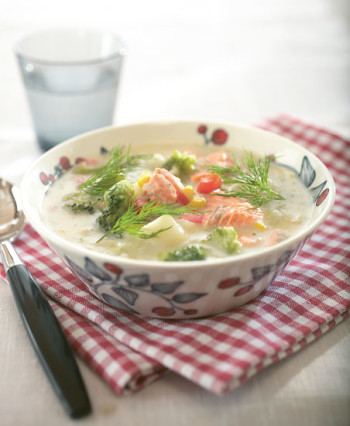
Photo: Pirkka Magazine
- 500 g salmon fillet, skinned
- 2 carrots
- 6 potatoes
- 2 onions
- 2 bay leaves
- 10 allspice berries
- 1 l fish stock or water
- salt and black pepper
- 25−50 ml fresh dill, chopped
Peel and chop the vegetables. Cut the salmon fillet into cubes. Bring the fish stock or water to the boil and add the seasonings and vegetables. Boil until the vegetables are almost done. This will take around 15 minutes depending of the size of the chunks. Add the fish and simmer for a couple of minutes until cooked. Check the taste and add salt and pepper if necessary. Sprinkle with dill.
Many people in Finland prefer their salmon soup creamy. Follow the above recipe but cut the volume of water or fish stock down to 800 ml. Add 200 ml of cream after the salmon and bring the soup to the boil. To finish, sprinkle with dill.
You can replace some of the potatoes with parsnip and chopped leek and use chives with or instead of dill to season the soup.
Vorschmack with potato salad and beetroot crisps
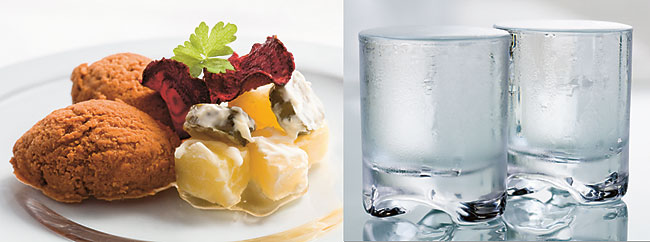
Vorschmack is a dish that originates from central and eastern Europe. It found its way into the hearts and onto the dining tables of Finns when it was made popular by the Finnish war hero, Marshal Mannerheim. He enjoyed this favourite dish of his with a spiced schnapps that later became known as “the Marshal’s schnapps”.Photo: Simply Scandinavian/Kimmo Saira
For the vorschmack:
- 1 kg boneless lamb
- 200 g beef, such as silverside
- 50 g pickled herring
- 50 g fillets of anchovy
- 2 large onions
- 300 ml beef stock
- 100 ml tomato purée
- 3 garlic cloves
- white pepper
For the potato salad:
- 400 g waxy potatoes
- 200 g Russian-style pickled gherkins
- 20 ml Russian-style sourcream (smetana)
- clear honey
For the beetroot crisps:
- 200 g medium-sized beetroots
- 20 ml cooking oil
Remove membranes and fat from the lamb and the beef. Chop the meat into pieces the size of the tip of your thumb. Put the pieces of meat and chopped onions on a baking tray and roast in the oven at 200 °C for approximately 10 minutes. Leave the meat and onion mix to cool and then put the mix together with the garlic, the herring and the fillets of anchovy through a mincer until they resemble a coarse paté.
Blend the tomato purée, beef stock and freshly ground white pepper into the paté. Pour the mixture into a casserole dish and cook in the oven at 150 °C for at least 4 hours. Check that the paté does not dry while in the oven. Add beef stock, if necessary.
Boil the potatoes. Leave them to cool and peel them. Chop the potatoes and the pickled gherkins into dice-sized pieces. Mix them together and add the smetana. Serve the potato salad with honey.
Wash the beetroots and cut them wafer thin using a cheese slicer. Pour oil into a small saucepan and heat until very hot. Put beetroot slices into the hot oil and cook for a minute or two. Remove the slices from the oil using a perforated ladle or a sieve and leave to dry on a kitchen towel. Serve with the Vorschmack and the potato salad.
Recipe source: Simply Scandinavian*
Trumpet chanterelle and elk sauté

Photo: www.tiesydameen.fi
For the dough:
- 800 g frozen elk (or other venison) meat, slightly defrosted and carved into chips
- 1 onion, chopped
- 1 tbsp butter
- 300 ml beer
- 2 handfuls of dried trumpet chanterelles
- salt
- a few juniper berries, crushed, if available
- crushed black pepper
Fry the elk meat and chopped onions in butter until browned. Add the beer and dried mushrooms. Season with salt, juniper berries and crushed black pepper. Cover the pan and simmer over a low heat for about 1 to 1 1/2 hours. Serve with mashed or duchesse potatoes.
Recipe source: HK-Ruokatalo Oy: www. tiesydameen.fi
Whipped lingonberry porridge

Photo: Simply Scandinavian/Kimmo Saira
- 1.2 l water
- 400 ml lingonberries
- 100 ml sugar
- 150 ml semolina
Cook the lingonberries for approximaterly 15 minutes in boiling water. Set aside and crush the berries with a tool such as a pestle. Strain the mixture using a fine-mesh sieve and save the juice. Put the juice back on the heat and add the sugar. When the juice starts to boil, pour in the semolina, stirring constantly. Boil for approximately 10 minutes or until the porridge is nicely thickened. Allow to cool for a while and whisk until light and fluffy using a handheld mixer. If the porridge is too sour add sugar according to taste. Serve with milk and sugar.
Recipe source: Simply Scandinavian*
Shrove bun (pulla)
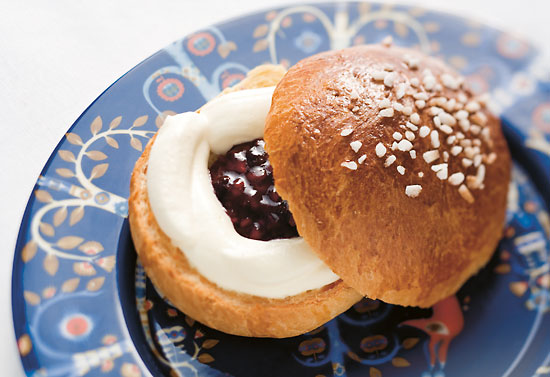
Shrove buns are a special treat around Shrove Tuesday.Photo: Simply Scandinavian/Kimmo Saira
For the dough:
- 500 ml milk, slightly warmed
- 50 g fresh yeast
- 200 ml sugar
- 1 egg
- 1 tsp ground cardamom
- ½ tsp salt
- 1.2−1.3 l plain wheat flour
- 150 g butter, melted and cooled
For the raspberry-blueberry jam:
- 250 g raspberries
- 250 g blueberries
- 250 g preserving sugar
200 ml double cream, chilled
Dissolve the yeast in the slightly warmed milk. Add the beaten eggs, the sugar, the salt and the cardamom. Pour part of the flour into the mix and stir well until it forms a thick gloop. Beat the mixture well for a minute or two and add the rest of the flour little by little, stirring occasionally. Add the butter and stir the mixture well for a while. If it is still too thin, add some more flour. Knead the dough for approximately 5 minutes. Leave the dough to rest and allow it to rise in a large dish for approximately 30 minutes. Cover the dish with a towel.
Turn the dough onto a floured board and shape the dough into fist-sized balls, rolling them between the palm of your hand and the board. Place them on a baking tray. Brush each one with some beaten egg and sprinkle sugar nibs on top. Bake in the oven at 220 ⁰C for 10−15 minutes or until the buns are beautifully brown.
Clean the raspberries and blueberries and rinse them. Put the berries into a saucepan and add 50 ml of water. Pour the sugar into the saucepan just before the mix starts boiling, stirring well. Boil the jam for 10−15 minutes, stirring occasionally. Skim the froth off the jam and leave to cool for an hour. Pour the jam into clean jars or use it straight away for filling the halved buns.
Whip the chilled double cream until it forms firm peaks and add the sugar. Cut the buns into halves lengthwise and carve a small hole into the middle of the lower halves. Put a heaped teaspoon of rasberry-blueberry jam into the holes and pipe a ring of whipped cream around the jam.
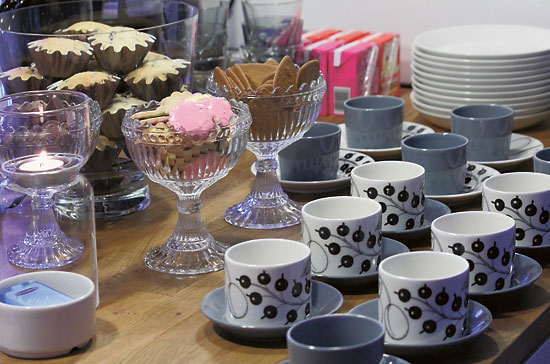
Finns are the biggest per capita consumers of coffee in the world. It is always the right time for a cup of coffee, whether morning, afternoon or after dinner. Coffee is also an essential part of festivities. During the day a cup of coffee is often enjoyed with a simple pastry, such as a pulla (bun). At parties the selection is bigger.Photo: Vastavalo/Ia Ahonen
Measures
The following conversions are approximate, but sufficiently accurate for normal cooking purposes.
|
|
|||||||||||||||||||||||||||||||||||||||||
|
||||||||||||||||||||||||||||||||||||||||||
* Simply Scandinavian:
Travelling in time with Finnish Cuisine and Nature by Tero Kallio and Kimmo Saira
Raikas Kustannus Ltd, 2008



